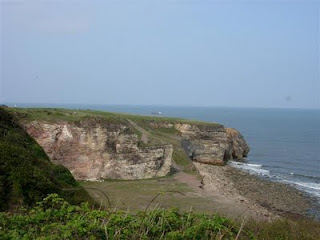© Copyright Brian Abbott and licensed for reuse under this Creative Commons Licence.
This abandoned corner of the North-East has seen more than its fair share of industrial blight over the years. The heights of Nose’s Point and thereabouts have seen ironworks, a bottle factory and a chemical works built, thrive and demolished over the years – as well as, of course, Dawdon Colliery, which closed in 1991. Add to the mix random railways and a ballast dumping ground for merchant ships, and it is a wonder that it looks as scenic as it does today. Blast Beach
Such was the state of the area prior to its recent clean-up that the headland used to protrude further out to sea thanks to the dumping of industrial waste – and a platform, or crust, of compacted slag and slurry covered the beach, again extending far out into the waves (you can still see the edge, or lip, of this artificial surface where the rocky beach abuts the land). It looked so barren that it was used in the opening scenes of the film Alien 3 in 1992.
Such was the state of the area prior to its recent clean-up that the headland used to protrude further out to sea thanks to the dumping of industrial waste – and a platform, or crust, of compacted slag and slurry covered the beach, again extending far out into the waves (you can still see the edge, or lip, of this artificial surface where the rocky beach abuts the land). It looked so barren that it was used in the opening scenes of the film Alien 3 in 1992.
With the retreat of industry, nature – with a little help from man – has largely wiped the grime from the shores and the cliffs. However, with the protective coating of waste now gone, coastal erosion is a major concern.















